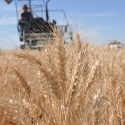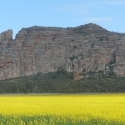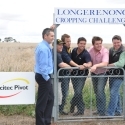Longerenong Cropping Challenge 2009
The Longerenong Cropping Challenge is proudly supported by
The final results are in for the Longerenong Cropping Challenge for 2009. Incitec Pivot Fertilizers and Longerenong College initiated a wheat cropping competition that was open to teams of local agronomists, consultants, farmers and students. Although a competition with the target to produce the highest gross margin, the real objective is to share information and opinions about agronomy options, as well as a“bit of fun” for everybody.
Teams selected a range of varieties from Olympic through to the more recent developments such as Correll and Gladius. Sowing times were also selected by the teams, and most sowed in early May. About half the teams topdressed with either UAN or urea. Harvest was in early December.
The best laid plans for the various teams were – like the plans made by all grain producers – at the whim of the season, especially with conditions immediately following sowing and around topdressing times. There was a dry time after sowing in May that may have affected emergence of those crops sown around mid-May. Even though the year ended up as a decile 8 growing season rainfall, September and October had a huge impact on what was a fantastic yield potential in August. The dry first half of October, coupled with a week of +30oC had a huge effect on grain yield as well as quality. It is likely that the late topdressings of N had little impact on yield.
· Even the best agronomy plans are subject to seasonal impacts that can drastically affect yields and returns.
Figure 1 Rainfall during the 2009 growing season at Longerenong
Establishment for most crops was good, but the Hammertime plots seemed to be ahead of the rest for most of the season. This group used a high S fertilizer at seeding, and while there are many other things that could have affected the outcome, this does raise the issue of S nutrition for wheat. The soil test value was 4 mg/kg for KCl-40 S, which is in the marginal range for wheat. While growers are aware of the S requirements of canola, wheat also has a need especially where long term use of low S fertilizers (eg MAP) has occurred.
· S is important and keeping an eye on soil test values is a good way to monitor
Table 1 shows the costs, yields, prices and gross margins for the 14 teams during 2009. The average cost per hectare was $228 and this was made up of fertilizer ($84/ha), crop protection ($38/ha), seed and sowing ($66/ha) and harvesting ($40/ha). Some teams spent a lot more, which was mainly top dressed N, which did not always show up in the improved yield due to some dry spells around top dressing, as well as a dry finish.
· So, adding more inputs is not the answer, but selecting key inputs and getting the timing right – especially nutrition – is important.
Even though the highest yield crops are not always the most profitable, matching inputs to crop potential is important. Despite that, the best returns were with the crops that did yield well – the five most profitable crops all yielded above 4 t/ha.
· Go for yield, but manage costs
What was clear from this was that managing crop price – through forward contracting was an effective strategy for this season. With changing currencies, crop prices eased as harvest approached, and some groups took advantage of multi-grade forward contracts and were able to lock in some or part of their harvest. While the season was cruel and screenings were generally a problem, some teams received nearly $30 per tonne over the at-harvest price by forward selling. Most of the harvest for this challenge was GP1 due to screenings, although two groups managed H2 but Hammertime advanced soil a 100 t package of grain, but prices were higher at harvest for that grade. The highest grain price was for Rosella (soft wheat) delivered locally. For some teams, the screenings levels were just above the 5% limit and in a practical case, cleaning could held shift the grain up a grade.
· Marketing decisions have a huge impact on profitability and prices can be managed with forward contracts.
· Post-harvest cleaning to reduce screenings can help improve price by shifting the grain into the next quality bracket.
Table 1 Summary of costs, yields, prices and returnes for the Longerenong Cropping Challenge 2009. Full details of agronomy, costs, yields and prices are able to downloaded at the bottom of this page.
| Team name | Total costs $/ha | Yield t/ha | Average Price $/t (on farm) | Gross Margin $/ha |
| Longy Hammertime | 218 | 4.65 | 195 | 689 |
| Longy Lectures | 166 | 4.02 | 191 | 602 |
| Green machine | 284 | 4.29 | 200 | 572 |
| Raging Reds | 246 | 4.93 | 166 | 571 |
| Incitec Pivot Fertilizers 9P20N | 263 | 4.82 | 169 | 550 |
| No-Till Longy Legends | 182 | 3.53 | 203 | 536 |
| BCG Agronomy | 204 | 4.09 | 166 | 475 |
| BCG Yield Prophet | 314 | 3.98 | 196 | 465 |
| BCG, Making Conservation Pay | 151 | 2.81 | 217 | 459 |
| Team Agritech | 236 | 3.52 | 191 | 437 |
| Pacific seeds | 255 | 3.65 | 166 | 350 |
| Incitec Pivot Fertilizers Late Sowing | 195 | 2.67 | 191 | 316 |
| Longy Endurance | 267 | 3.42 | 170 | 315 |
| Old Timers | 210 | 0.95 | 166 | -52 |
Means | 228 | 3.67 | 185 | 449 |
Some team members from the Longerenong Cropping Challenge 2009.
Download detailed filed here




